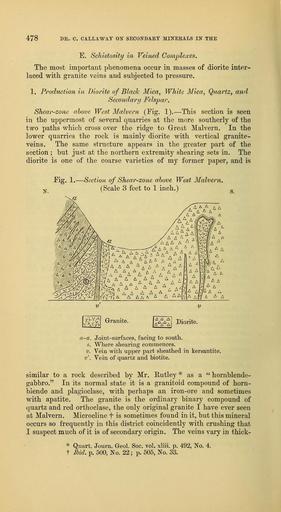MAKE A MEME
View Large Image

| View Original: | The_Quarterly_journal_of_the_Geological_Society_of_London_(13960462503).jpg (1154x2105) | |||
| Download: | Original | Medium | Small | Thumb |
| Courtesy of: | commons.wikimedia.org | More Like This | ||
| Keywords: The Quarterly journal of the Geological Society of London (13960462503).jpg 480 DR C CALLAWAY OX SECONDARY MHSTERALB IN THE <br> the folia are seen to consist mainly of alternations of quartz and <br> felspar in small grannies <br> In the centre of the exposed part of the zone is another band of <br> sheared granite 407 This is as much like a true gneiss as it <br> can very well be Seams of quartz of a coarser grain than <br> any of the preceding alternate with seams of mixed felspar white <br> mica and finely granular quartz The felspars of small size un- <br> striated and a little dirty are in corroded forms or occasionally <br> idiomorphic The mica is abundant and is usually in lath-shaped <br> sections <br> The changes here described are those commonly observed in the <br> conversion of granite into gneiss Felspar is reconstructed in small <br> granules or in crystals and white mica is produced out of it Secon- <br> dary granular quartz is also formed <br> Diorite on the margin of the shear-zone shows the following cha- <br> racters Hornblende is in large crystals of various shades of green <br> and brown Pleochroism is fairly strong especially in sections <br> parallel to the base in which the double system of cleavages is very <br> distinct The sections which are approximately parallel to the sides <br> of the prism show a tendency in the mineral to break up along the <br> cleavage-planes giving the well-known reedy structure There <br> is also some crushing and contortion of the crystals A little chlo- <br> rite is formed from the hornblende The entire quantity of felspar <br> is very small Some of it shows the twinning of a plagioclose but <br> a large proportion is untwinned It is mainly replaced by epidote <br> and white mica Spicules of haematite or limonite are abundant <br> and often occur in the white mica lying parallel with the lamellae <br> Five slides 400-404 were taken a few inches apart commen- <br> cing outside the visible zone and proceeding to about the middle <br> The following changes were noted ” The hornblende becomes more <br> and more reedy and broken up and in one of the later slides it <br> occurs in detached spicules sections parallel to prism in minute <br> rhombic forms sections parallel to base and in various irregular <br> fragments The proportion of hornblende diminishes from about <br> one half to one tenth of the slide The felspar decreases in quan- <br> tity till in the last of the series it cannot with certainty be detected <br> and in the last but one it occurs only in a small number of minute <br> clear crystals and a few scattered granules which appear to be the <br> eroded remains of crystals It is sometimes striated sometimes <br> not Its place is taken very largely by white mica In the first <br> slides the mica is seen to be penetrating the felspar from the side or <br> wholly enclosed within it and it shows a progressive increase <br> through the series It appears mostly in lath-shaped sections whose <br> longer axes lie in all directions in the earlier slides ; but in the later <br> and more schistose specimens they tend to run with the general <br> foliation As the abundant appearance of white mica in diorite at <br> shear-zones is a point of some interest a diagnosis of this mineral <br> from a similar rock-specimen will be given further on Xo 3 7 <br> p 493 <br> Epidote occurs in considerable quantity in all the slides Much 36940307 113696 51125 Page 478 Text 45 http //www biodiversitylibrary org/page/36940307 1889 Geological Society of London Biodiversity Heritage Library The Quarterly journal of the Geological Society of London v 45 1889 Geology Periodicals Smithsonian Libraries bhl page 36940307 dc identifier http //biodiversitylibrary org/page/36940307 smithsonian libraries Information field Flickr posted date ISOdate 2014-04-21 Check categories 2015 August 26 CC-BY-2 0 BioDivLibrary https //flickr com/photos/61021753 N02/13960462503 2015-08-26 05 57 06 cc-by-2 0 PD-old-70-1923 The Quarterly journal of the Geological Society of London 1889 Photos uploaded from Flickr by Fæ using a script | ||||